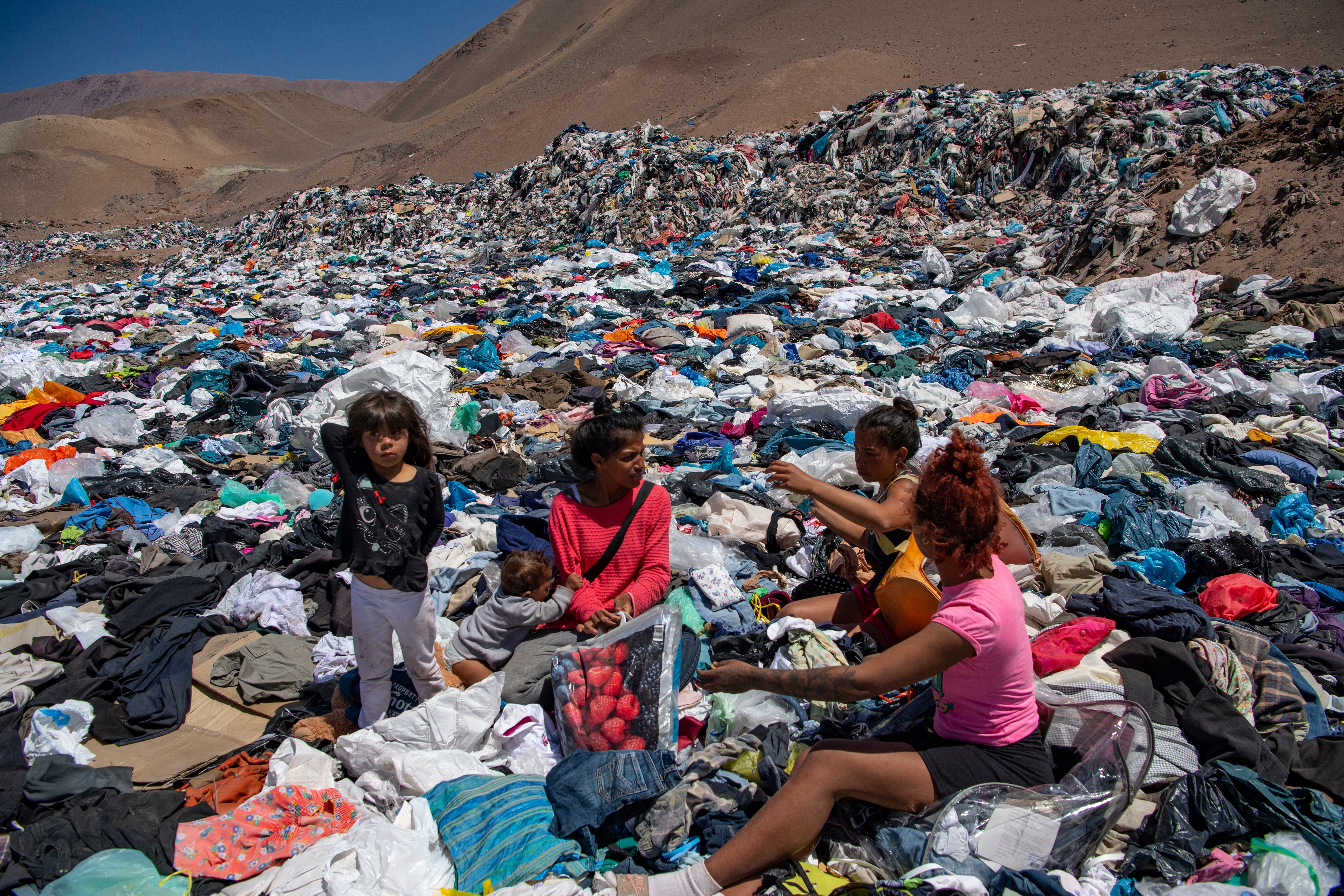Last month, ex-Blue Peter presenter and children’s author Konnie Huq made headlines when she revealed that she hadn’t bought any clothes in 20 years.
“The older I get, the more comfy I feel in my own skin,” she said while promoting a new climate action anthology for kids, adding: “I’m much happier opting out.”
The reason this captured so much attention was because, for most of us, the very idea of “opting out” is completely unheard of. In our current culture of vast overconsumption, not buying clothes doesn’t feel like a mere lifestyle choice, but a radical, counter-cultural act of defiance.
When it comes to fast fashion – and we have now reached a point where nearly all fashion is fast, thanks to a shift from seasonal collections to continuous “drops” of new items – the numbers are enough to make your head spin. It’s estimated that H&M produces 25,000 new styles per year, Zara 36,000, and industry leader Shein a mind-bending 1.3 million, adding, according to one investigation, between 2,000 and 10,000 new styles to its website per day. (Just to be clear – this is only the number of designs, not total items.)
The volume of clothing now produced is staggering. Worldwide, around 100 billion garments are made each year. To put that into context, there are only 8 billion people on Earth. In the last 10 to 15 years, the fashion industry and, consequently, our buying habits and relationship to clothes, has gone through rapid transformation, says Tom Crisp, the sustainable fashion MA course leader at Falmouth University.
“Because brands and global groups are driven by the growth logic of capitalism, they have to continually sell more to ensure that their shareholders get return on their investment,” he says. “This means that the amount of clothing being produced has grown exponentially, and I think we can see that quite openly in the way that Shein and Temu have exploded onto the marketplace.”
This continual growth has sparked an insatiable need for “newness”. Microtrends lasting days, not months, have emerged; clothes have simultaneously become so cheap that consumers no longer buy one item and expect to have it for 10 years but buy five items to dispose of after a couple of wears. The UN Environment Programme estimates that, between the years 2000 and 2014, people started buying 60 per cent more clothes and wearing them for half as long.
“We’ve got to this point where no one has a real relationship with their clothing anymore,” says Crisp. “It’s just something that we put on and then we can chuck it away without necessarily thinking of where it’s come from and what happens to it when we get rid of it.”
The “where it comes from” part of the equation is often obscured from the consumer. But this is key to understanding how broken the system is, says social entrepreneur Safia Minney, the founder and former global CEO of Fair Trade fashion producer People Tree. “There needs to be a recognition that the current economic system is dysfunctional,” she says. “We’ve got this absolute failure to pay anything close to a liveable wage. We have so many people now who are working in modern slavery conditions.”
The only way, logically, that a T-shirt can cost you £2, is if the garment worker who made it is paid pennies (wages for production will scarcely exceed 3 per cent of the price you pay in the shop). Fashion Revolution’s “Who Made My Clothes” campaign has attempted to shine a light on this, showcasing real-life pattern cutters, seamstresses and quality control workers so that consumers can put a face to the human beings behind their clothes. But even as our awareness around the problematic nature of fast fashion has grown, our buying has sped up.
“The rise in awareness is not shifting behaviours,” Lizzie Rivera, founder of sustainable lifestyle guide Live Frankly, tells me. “And I think the planet has become central to the argument, but people are also still being exploited in supply chains and they remain largely hidden from view.”
We’ve got to this point where no one has a real relationship with their clothing anymore
Why haven’t our actions changed in line with our knowledge of the harm that this scale of mass production is causing? It’s no coincidence, according to Crisp, that the rise of social media has coincided with the rise of our unhealthy shopping mentality.
“Our attention span has dropped. We give a piece of media two seconds to know whether or not we’re going to interact with it – it used to be seven seconds. Things like TikTok have accelerated the idea of newness and the constant refresh of what you’re seeing. And fashion is now part of that constant stimulation, where we get that small rush of buying something new and then, actually, it doesn’t last. And we go, ‘I don’t know what I bought that for.’ And we discard it.”
But discard it… where? These days, it’s much cheaper to make clothes from synthetic fibres than natural ones, maximising profits for brands and keeping garments cheap for customers. But polyester, which accounts for 60 per cent of new garments, is plastic made from oil. Aside from the fact it’s produced by extracting fossil fuels, it is incredibly difficult to recycle. It doesn’t biodegrade. It will be around for up to around 200 years. And, in the meantime, it’s causing untold damage.
According to a European Parliament report on the environmental impact of textile production, a single laundry load of polyester clothes can discharge 700,000 microplastic fibres that end up in the food chain. (The majority of microplastics from textiles are released during the first few washes, which, when we’re talking about fast fashion, means many more “first washes” as people buy ever-more new things.) And that’s before we get to the discarding part – throwing clothes to that magical, mythical land of “away”.

“Away”, in 57 per cent of cases, equals landfill. Some 25 per cent of global clothing waste is incinerated. Even if you think you’re doing good by donating unwanted clothing to charity, a whole other problem emerges. Charities have themselves become overwhelmed with donations, and often ship the excess clothing to the global south, where the volume has grown to completely unmanageable proportions.
“Just stop. There’s just too much clothing in the world. Just f***ing stop,” says Ghanaian designer Chloe Asaam on new Netflix documentary Buy Now! The Shopping Conspiracy, the palpable anger and desperation in her voice like a punch to the gut.
Ghana has become a dumping ground for unwanted second-hand clothes from the global north – an industry referred to as “dead white man’s clothes”. Containers filled with donated clothing or brands’ own surplus stock are bought, sight unseen, by entrepreneurs hoping to sell what’s inside for a profit. But an estimated 40 per cent of what arrives in Ghana now is deemed worthless and goes immediately to landfill. In Buy Now!, sweeping shots show the country’s beaches packed with piles upon piles of discarded clothes from H&M, Zara, George by Asda, Gap. “There are 30 million people in Ghana and we have 15 million pieces coming in every week,” says Asaam bluntly.
It’s why the thriving second-hand fashion market which has rocketed in popularity over the last decade simply isn’t the silver bullet that’s going to make our shopping addiction sustainable. In fact, it may be doing the exact opposite.
“All ‘recycling’ and second-hand has done has opened up new markets for even more consumption,” explains Crisp. “People buy more because it’s cheaper, and people see it as better for the planet. It’s a massive red herring.”
We need to stop putting such emphasis on new
Sites like Vinted and charity shops have become flooded with poor-quality goods from fast-fashion brands, often with the tags still on. Sellers or donors feel like they’re “doing their bit” while clearing wardrobe space to buy even more new clothes; buyers feel like they’re “doing their bit” by purchasing second-hand instead of new, while unwittingly contributing to the same ever-expanding fast-fashion commercial funnel.
“It is good to buy second-hand, and it’s good that that market exists, but we definitely do need to examine it,” says Sara Arnold, activist and co-founder of degrowth campaign group Fashion Act Now. “I worry that it’s just adding extra capacity to the system. Within a growth-based system, if you create efficiencies, then you just grow the system. Are we actually buying less new stuff because we’re buying second-hand, or do we just add on all this stuff that we think has no impact? And do we just consider that we can dispose of things because that market exists?”
Big brands are doing little to nothing to tackle the issue. Despite the fashion industry accounting for around 10 per cent of global carbon emissions and 20 per cent of global clean water pollution, only 3 per cent of fashion brands have a proper Climate Action Plan in place, says Minney. Most labels are guilty of some form of greenwashing, whether it’s launching a “sustainable” line while continuing to make the vast majority of profits from unsustainable practices, or offering a clothing “recycling” service that simply sees items passed on to less wealthy nations to deal with.
In response, some elements within the industry are calling for “degrowth”, setting out a vision that sees production and consumption go drastically down. One oft-quoted figure from Kate Fletcher and Mathilda Tham, who came up with a model of system change for the fashion industry called “Earth logic”, suggests we need a planned reduction of between 60 to 95 per cent if fashion is to become sustainable.

So how do designers and brands making new items fit into a degrowth model? By creating in a slow, intentional way, says Arnold – which inevitably means treating and paying workers properly, carefully considering the sourcing of materials, having full supply chain control, and thinking about every step of the production process holistically. It’s only really possible to do this when producing on a fairly small scale in a more localised way.
Lora Gene is one such brand, a Bulgarian designer who produces high-quality garments in Bulgarian factories, where textile workers’ skills and craft are respected and compensated properly, and clothes are constructed from all natural fibres like wool and silk to ensure they will biodegrade. Valentina Karellas is another designer committed to creating without exploitation. She handmakes all of her wool products herself using yarn that would have otherwise gone to waste, with control over the entire process.
She also runs a visible mending service to add life and character to clothes when they become ripped or damaged. This idea, too – of loving our clothes and repairing them to extend their lifespan, rather than treating them as disposable – is key to cultivating a more sustainable attitude towards fashion.
Lisa Matzi first discovered the joys of repair when she darned a hole in a beloved jumper. She launched her own business, Rebel Patch, selling bespoke, artist-designed iron-on patches to repair holes in clothes, and began teaching others how to mend – eventually running workshops that created a sense of community as people chatted and connected while sewing.
It may sound a bit cliche, but if you repair something yourself, your relationship just instantly changes
“It may sound a bit cliche, but if you repair something yourself, your relationship just instantly changes,” she says. “You’ve spent a bit of time on it. You’ve put care into it. And then you’ve added your own personal stamp to it – and you automatically have a way deeper connection to that piece of clothing.”
For consumers, then, the only real “sustainable” fashion choice is to completely reframe the unhealthy mindset we’ve developed around what we wear. We need to love our clothes, take care of them, repair them and keep them for as long as we can. We need to buy with intentionality, seeking out smaller makers who are really focused on creating garments in the right way. We need to rehome responsibly where possible, engaging in events like community clothes swaps.
But, there’s no way around it: at the end of the day, we should all be more Konnie Huq. Because at the end of the day, the most pressing objective is to massively cut our consumption. “We are in a really, really critical situation,” says Safia Minney. “We need to slow down.” One report she authored suggested that we should limit our buying to three items a year; Crisp advises setting yourself a challenge of going six months without buying any clothes to develop sustainable habits.
“We need to stop putting such emphasis on new,” agrees Rivera. “And we need to be honest with ourselves – if what we’re doing is harmful to the planet or others, why are we doing it?”
The Independent and Falmouth University are teaming up to deliver a unique event entitled “Our Climate Present”– an immersive day of talks and workshops that will delve into the importance of sustainable fashion and solutions. The event will take place on Thursday 5 December, to mark World Climate Day (8 December) at the Fashion and Textile Museum in London. Book your free tickets here







